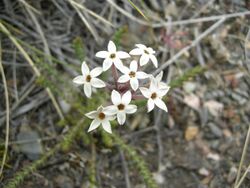Biology:Arjona patagonica
| Arjona patagonica | |
|---|---|

| |
| Scientific classification | |
| Kingdom: | Plantae |
| Clade: | Tracheophytes |
| Clade: | Angiosperms |
| Clade: | Eudicots |
| Order: | Santalales |
| Family: | Schoepfiaceae |
| Genus: | Arjona |
| Species: | A. patagonica
|
| Binomial name | |
| Arjona patagonica Hombr. & Jacquinot ex Decne.[1]
| |
| Synonyms[2] | |
| |
Arjona patagonica is a species of flowering plant in the family Schoepfiaceae native to southern South America.[3]
Taxonomy
Arjona patagonica was given its scientific name by Jacques Bernard Hombron, but a full species description was published by Joseph Decaisne in 1853 in the second volume of botany of the Voyage au Pôle Sud et dans l'Océanie sur les corvettes l'Astrolabe et la Zélée. In the title page of this book, both Hombron and Honoré Jacquinot are credited as authors, although this apparently may have been in error. Either way, only Hombron is credited as authority for the name A. patagonica by Decaisne.[4]
A. rigida was described in 1878 in order to replace the A. tuberosa described by Rodolfo Amando Philippi in 1864, the plant described by Philippi was not the A. tuberosa originally described by Antonio José Cavanilles. It was later regarded as a synonym of A. patagonica.[2]
Carl Skottsberg placed A. patagonica in his section Euarjona in 1916, together with A. tuberosa.[5][6]
Distribution
In Argentina it has been collected in the provinces of Buenos Aires, Chubut, La Pampa, Mendoza, Neuquén, Río Negro, San Juan, Santa Cruz and Tierra del Fuego. In Chile it has been collected in the regions of Araucanía, Coquimbo, Libertador Bernardo O'Higgins, Magallanes and Valparaíso.[2]
Uses
According to a 1968 report by Martínez Crovetto on the (former) uses of plants (i.e. ethnobotany), this species formed an important part of the diet of the Ona people, who called it téen in their language, one of their only sources of carbohydrates. The tubers are 5 to 9mm wide, and up to 20cm long. The tubers shrink to 2mm in diameter during flowering in Spring, and are best harvested in fall months of March and April. They contain mostly water and some polyphenols. The plant is eaten by livestock; it has been rated as nutritionally extremely poor as a fodder in terms of palatability, digestibility and crude protein content according to the 1987 Lara & Cruz system.[7]
References
- ↑ "Arjona patagonica". Royal Botanic Gardens, Kew, Harvard University Herbaria and Australian National Herbarium. https://www.ipni.org/n/780025-1.
- ↑ 2.0 2.1 2.2 "Arjona patagonica" (in es). Instituto de Botánica Darwinion. 2018. http://conosur.floraargentina.edu.ar/species/details/24884.
- ↑ "Arjona patagonica". Plants for a Future. http://www.pfaf.org/user/Plant.aspx?LatinName=Arjona+patagonica.
- ↑ Decaisne, Joseph (1853) (in fr, la). Voyage au Pôle Sud et dans l'Océanie sur les corvettes l'Astrolabe et la Zélée. Paris: Gide et J. Baudry. p. 5, 22, 23. doi:10.5962/bhl.title.9604. https://www.biodiversitylibrary.org/page/10349111.
- ↑ Nickrent, Daniel L. (19 October 2010). "Schoepfiaceae Blume". Southern Illinois University Carbondale. https://parasiticplants.siu.edu/Schoepfiaceae/description.html.
- ↑ Skottsberg, Carl (1916). "Zur Morphologie und Systematik der gattung Arjona Cav." (in de). Svensk Botanisk Tidskrift 10 (4): 526–528. https://www.biodiversitylibrary.org/page/44238149. Retrieved 23 December 2021.
- ↑ Erwin Domínguez Díaz; Pedro León Lobos (2008). "Arjona patagonica" (in es). Portal Frutícola. https://www.portalfruticola.com/noticias/agrotecnia/arjona-patagonica-plantas-nativas-comestibles-fuente-potencial-de-nuevos-cultivos/.
Wikidata ☰ Q15602093 entry
 |


